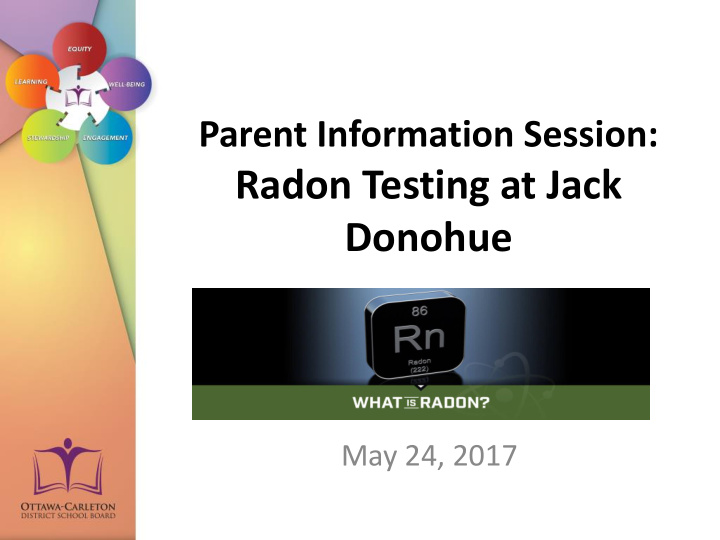



Parent Information Session: Radon Testing at Jack Donohue May 24, 2017
Agenda 1. Welcome and Introductions Cindy Alce, Principal 2. Overview of OCDSB Testing Brett Reynolds, Superintendent 3. Information on Radon Gas Kelley Bush, Head Radon Education and Awareness Health Canada 4. Results at Jack Donohue Miro Vala, Manager Facilities Clint Vester, Supervisor, Health and Safety 5. Remediation and Next Steps Miro Vala, Manager Facilities Clint Vester, Supervisor, Health and Safety 6. Questions
OCDSB Radon Testing Program • OCDSB has a voluntary radon testing program; • 5 year district-wide testing cycle; • Long-term testing for better accuracy – 2 testing periods per site/school year; • Testing done to sample different areas of the school
Jack Donohue Radon Testing • Reviewed ventilation systems in school in 2008 in response to radon testing; • School was one of 34 sites tested this year; • 1 of 2 tests completed; • Elevated levels in 1 st test led to review of building ventilation and interim short-term testing; • Long-term testing will continue for this year and next;
General Information from Health Canada • What is radon? • How is it measured? • What are the guidelines?
What is Radon Gas? • A radioactive gas formed naturally by the breakdown of uranium in soil, rock and water. • As a gas, radon can move freely through the soil enabling it to escape to the atmosphere or seep into buildings. • It is not detected by the senses; i.e. you cannot see, smell, or taste it. Radon is a radioactive gas found naturally in the environment.
HOW RADON ENTERS A BUILDING • Through cracks, openings or gaps in foundation walls or floors • The air pressure inside the building is normally lower than the pressure underneath or around the foundation • This difference in pressure acts like a vacuum drawing radon in through foundation cracks and other openings
How is Radon Gas Measured? • Canadian guideline for radon in indoor air for dwellings is 200 becquerels per cubic metre (200Bq/m3). No Action Required Remediate within 2 years Remediate within 1 year <200 Bq/m3 200-600Bq/m3 >600BQ/m3
Initial Results at Jack Donohue • 112 day testing period over fall/winter indicated elevated levels in some rooms; • Results were measured in 19 rooms/areas of the school: – 7 areas had results lower than 200 Bq/m3; – 7 areas had results between 200-600 Bq/m3; and – 1 area had results above 600 Bq/m3.
Follow-up test results • In accordance with Health Canada guidelines follow-up short-term testing was done in rooms with highest concentrations; • Follow-up testing done in 8 areas; • Levels dropped significantly in all but one area. As a result, – 5 areas had results lower than 200 Bq/m3; – 3 areas had results between 200-600 Bq/m3; and – No area had results above 600 Bq/m3.
Work Since Testing • Since test results, work undertaken to identify possible contributing factors; • Air handling system was operational, but was not functioning properly; • System was repaired prior to the follow-up testing and indoor air quality has improved;
Ministry of Labour Inspection • Experienced a work refusal yesterday; • Ministry of Labour inspected the site; • MoL has issued an order that there is no imminent risk to health and safety and staff were redirected back to work.
Remediation and Next Steps The following actions are planned: • Changes to the mechanical system operation and maintenance schedule to reduce the risk of any system malfunction; • Additional long-term radon gas testing will be done this school year and next year; and • Remediation work will be done over the summer to install separate ventilation system to vent radon gas from the ground directly to the outside.
Questions? More Information: https://www.takeactiononradon.ca/test http://www.hc-sc.gc.ca/ewh- semt/radiation/radon/index-eng.php
Recommend
More recommend